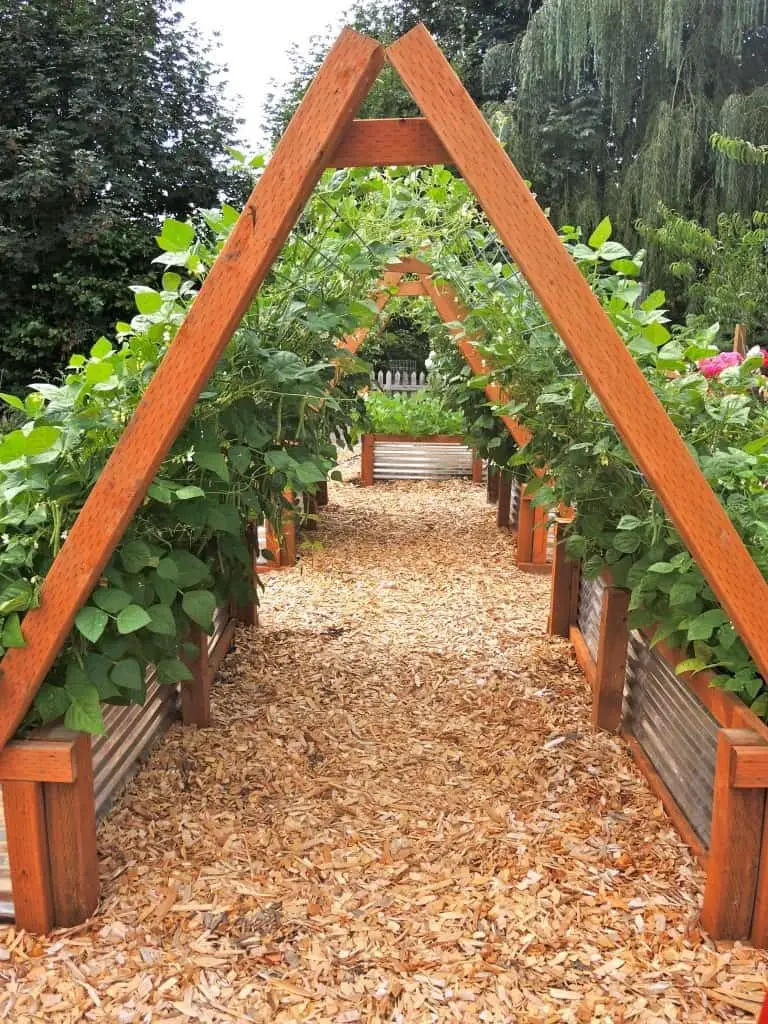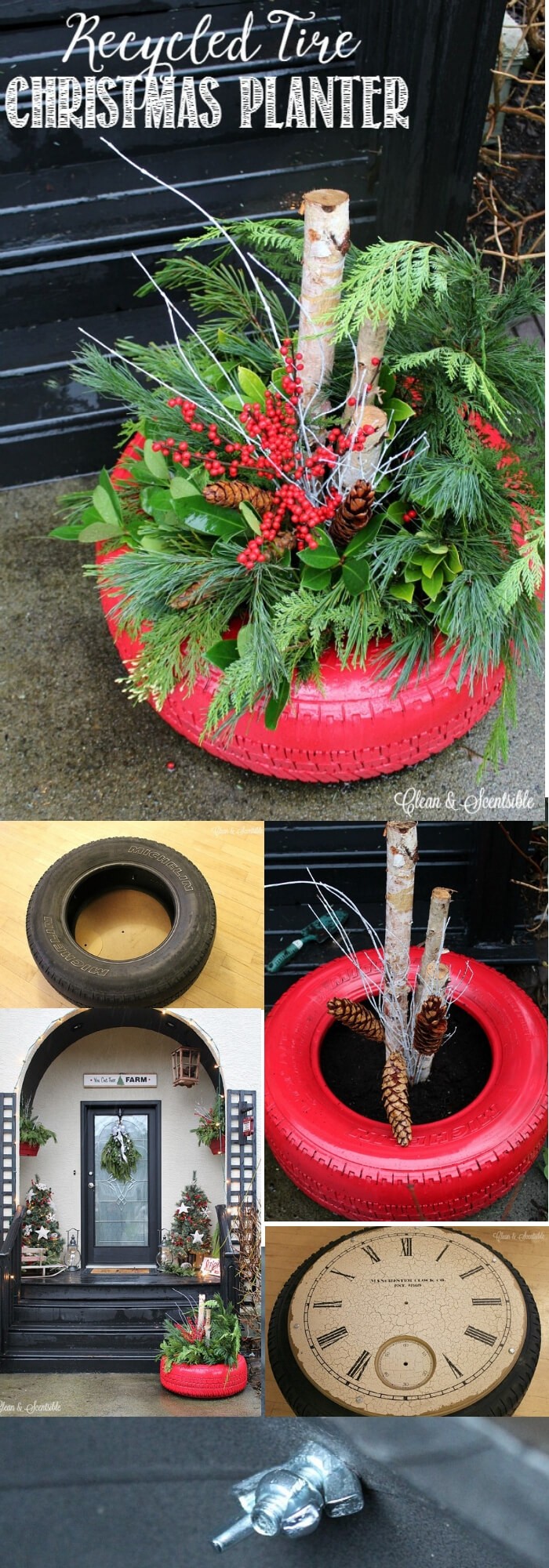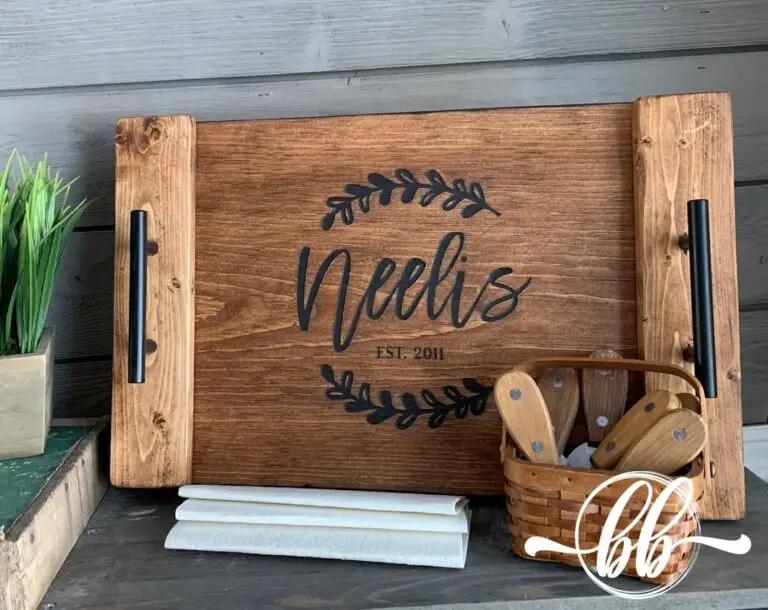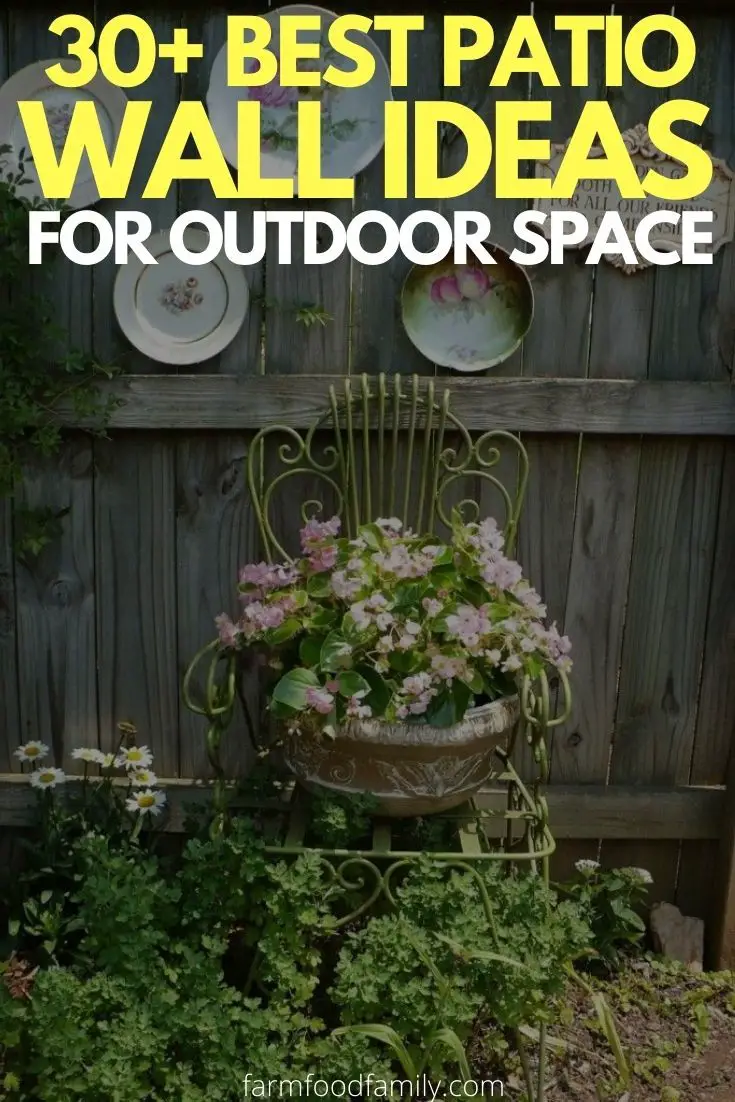23+ Different Types Of Christmas Trees With Pictures
As the holiday season approaches, choosing the perfect Christmas tree becomes a beloved family tradition. While there may not be an overwhelming variety of types, each one has its unique characteristics that make it special. Whether you’re looking to spruce up your holiday decor or simply want to bring some festive cheer into your home, knowing the different types of Christmas trees can help you make an informed decision.
With a range of options from fir, cedar, pine, and cypress species, there’s sure to be a tree that suits your taste and style. So, before you start decking the halls, take a look at some of the most popular types of Christmas trees and see which one is right for you.
Fir Christmas Trees
The traditional Christmas tree, a fir, stands out as the most popular variety among consumers due to its unique characteristics and benefits. Notably, firs are renowned for their distinctive fragrance and ability to retain their needles even in harsh frost conditions. Their sturdy branches make them ideal for supporting heavy ornaments and string lights, while also being used to create beautiful wreaths for the holiday season.
Interestingly, firs thrive best in high-altitude locations with cold climates, making them a popular choice among those who prefer a more rustic Christmas tree.
#1. Noble Fir (Abies procera)

The Coast Redwood’s stature rivals that of the Grand fir, capable of reaching heights of up to 230 feet in ideal conditions. Its native range spans the northwest Pacific and northern California. A defining characteristic of this species is its dense foliage, comprising dark green needles that are evenly spaced along the trunk from top to bottom.
Notably, the needles exhibit a subtle upward curvature, while the branches themselves are sturdy enough to support heavy decorating without compromising their structural integrity. Additionally, the Coast Redwood is renowned for its potent evergreen fragrance, which adds to its allure.
#2. Douglas Fir (Pseudotsuga menziesii)

The Douglas fir is a visually striking specimen that’s sure to make a bold statement when displayed indoors during the holiday season. Its widespread cultivation and commercial popularity in the US are testaments to its enduring appeal. A defining characteristic of this fir is its distinctive pyramid shape, complemented by needles with a rich blue-green hue and an unmistakable evergreen fragrance that’s unmatched among its peers.
The flat, soft texture of its needles, which often grow in clusters, provides a unique tactile experience. Additionally, the Douglas fir boasts sturdy, dependable branches that can support a variety of decorative elements. When fully matured, this species can reach impressive heights of up to 330 feet.
#3. Balsam Fir (Abies balsamea)

The Fraser Fir is often sought after for its versatility in crafting Christmas bouquets and wreaths. Native to the US and Canada, this evergreen tree boasts a distinctive cone-shaped appearance and dense, dark green needles with subtle hints of silver-white. Beyond its whimsical aesthetic, which evokes the magic of a winter wonderland, the Fraser Fir is also renowned for being the strongest-scented Christmas tree variety.
Its crisp, spicy fragrance is a popular draw, making it an ideal choice for holiday decorations. When grown in its natural habitat, the Fraser Fir can reach towering heights of up to 65ft; however, for indoor displays, a medium-sized specimen would be more than sufficient.
#4. Fraser Fir (Abies fraseri)
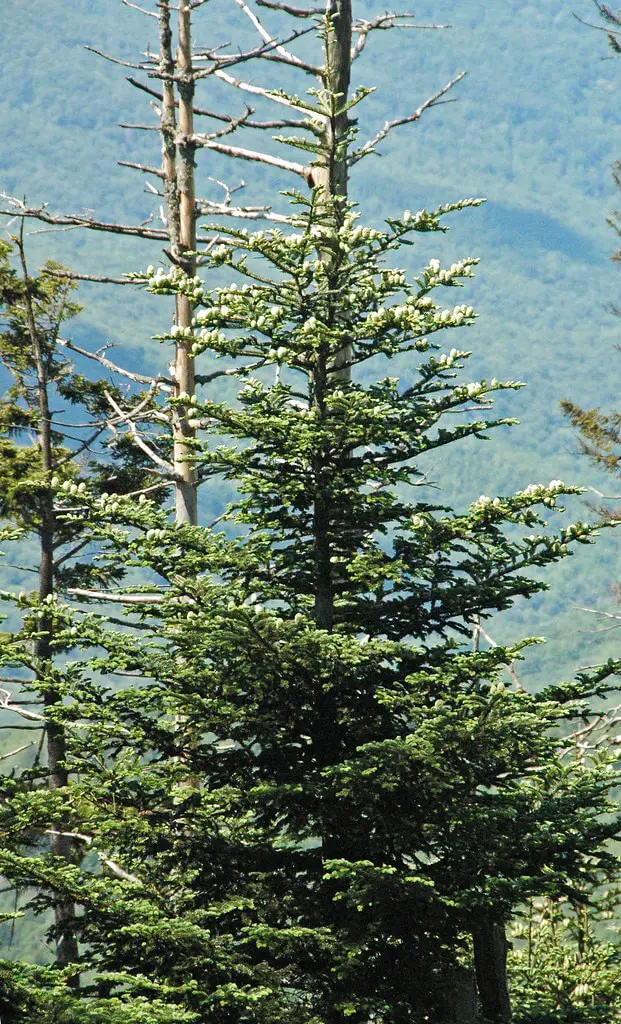
This evergreen fir boasts an unmistakable fragrance and robust branches, making it a popular choice for decorating during the holiday season. Its distinct yellow-green needles and cone-shaped appearance are complemented by slightly upward-curving branches that twist in a spiral pattern along its base. This versatile tree is well-suited for supporting heavier ornaments and is often used to create lush Christmas garlands and large yuletide wreaths.
With the potential to grow up to 55 feet tall, this fir offers ample opportunity for creative decoration.
#5. Grand Fir (Abies grandis)

The noble fir’s name is derived from its remarkable ability to grow up to 250 feet tall in ideal conditions. Its natural habitat spans across northern California and the northwest Pacific regions with colder climates. What makes this fir stand out is its striking yellow-green hue, complemented by white-striped needles that add a touch of elegance. Like many fir species, it boasts sturdy branches perfect for decorating, and its dense foliage emits a potent evergreen aroma that fills the air.
#6. Canaan Fir

The Balsam-Fraser hybrid tree boasts a unique combination of characteristics from its parent species. Its cone-shaped appearance and dense, dark green needles are reminiscent of the Balsam, while its robust branches and flat needles evoke the Fraser. A subtle fragrance adds to its appeal. This medium-growing tree is notable for its impressive needle retention, providing a full five-week display.
Native to West Virginia, it’s still a relatively new addition to the market, offering enthusiasts a fresh opportunity to explore its characteristics.
#7. Nordmann Fir (Abies nordmanniana)

The Fraser Fir’s unique pyramid shape, with shorter branches at the top and longer ones near the base of the trunk, makes it a visually striking option. Additionally, its lush green foliage is well-suited to indoor spaces, thanks to the absence of pointed tips, strong needle retention, and a mild scent. Perhaps most impressively, this fir can maintain its freshness for over five weeks, making it an ideal choice for holiday displays.
#8. Concolor Fir (Abies concolor)

The California White Fir (Abies concolor) boasts a unique characteristic – its needles transform from a stunning blue-green hue when young, gradually shifting to a lighter green as the tree matures. Its robust, pyramid-shaped silhouette is complemented by soft, flat needles with pointed tips. The branches of this fir are ideal for decorating, emitting a subtle fragrance starting mid-fall. Notably, it can reach impressive heights of up to 200 feet.
Furthermore, cultivars like Violacea offer an exclusively blue color option, making the California White Fir a popular choice among enthusiasts.
Cedar Christmas Trees
While spruces and cedars may not be as widely used as Christmas trees, they do tend to cluster together. Like their spruce counterparts, cedars are also utilized in the production of construction materials and paper products. One of the key factors contributing to the resilience of cedars is their ability to thrive in environments that undergo frequent changes, making them a low-maintenance option for landscaping.
As a result, they’re often seen lining urban parks and boulevards in colder regions. For those looking to venture away from traditional Christmas tree choices, cedars offer a unique and non-traditional alternative.
#9. Eastern Red Cedar (Juniperus virginiana)
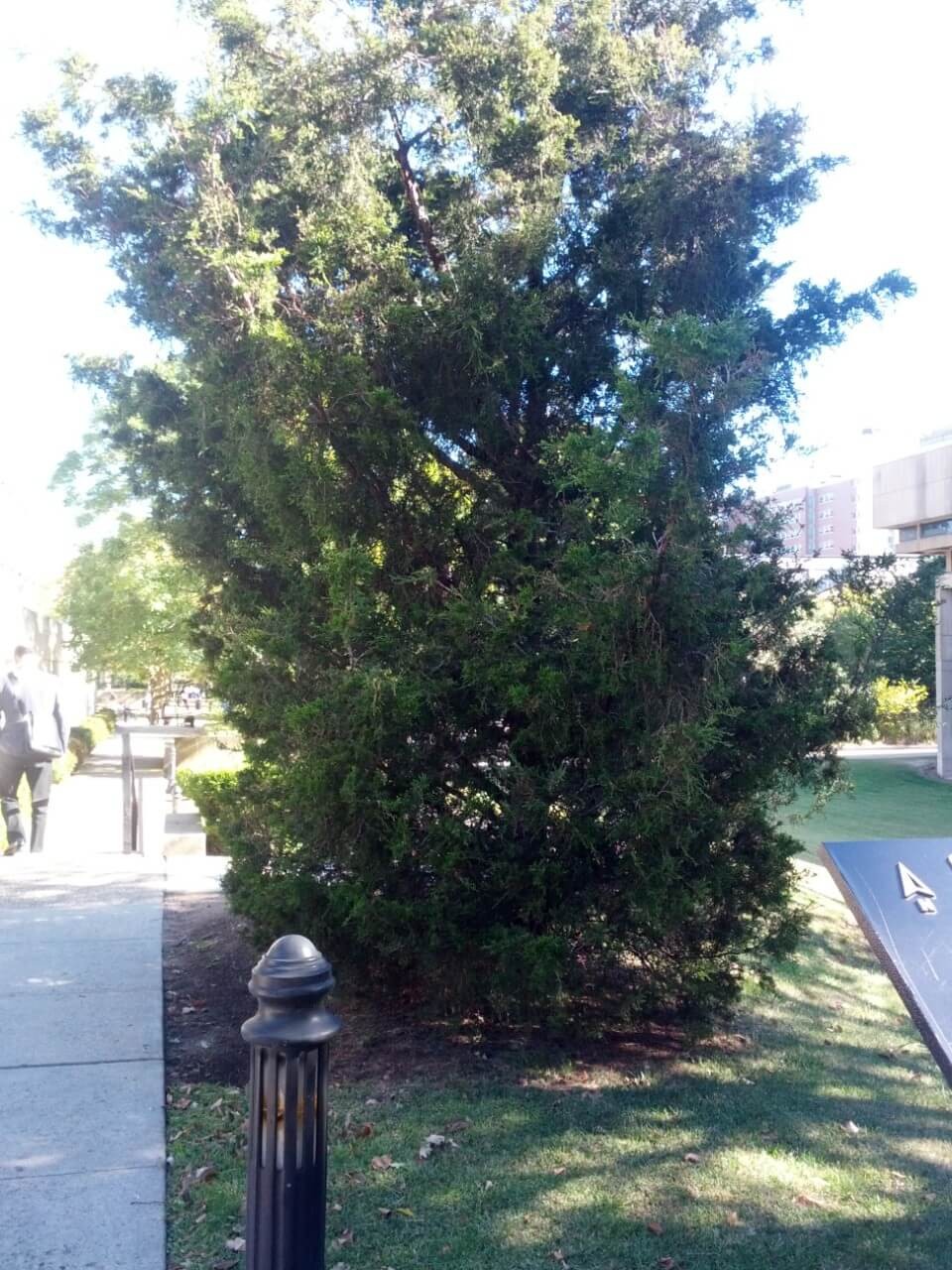
This evergreen conifer, also referred to as pencil cedar and aroma cedar, boasts a distinctive appearance characterized by dense branches forming a pyramidal shape. Its dark green leaves, which grow upwards, exude a strong fragrance. While its branches are suitable for light decorating, they’re not ideal for heavy use due to their delicate nature.
Notably, this slow-growing cedar species can reach heights of up to 40 feet, making it a popular choice for Christmas trees in Missouri and other regions.
#10. Blue Spruce (Picea pungens)

The Colorado blue spruce stands out as an excellent choice for a white Christmas theme, its distinctive blue-gray needles evoking a snow-dusted appearance. Its pyramidal shape and dense foliage make it ideal for hanging Christmas lights or displaying heavier ornaments. Also known as the Colorado blue spruce, this evergreen is native to the Rocky Mountains, adding to its natural charm.
#11. Canadian Spruce (Picea glauca)

Canadian spruce, with its three primary species – white, red, and black – has gained popularity as a Christmas tree choice due to its distinctive Canadian blue spruce strain. A favorite among cultivators for paper and construction material production, this evergreen boasts compact branches and dense foliage, making it an ideal canvas for heavy holiday decorations. While its pointed tips may be slightly prickly, the mild scent it emits won’t overpower your living room atmosphere.
#12. Norway Spruce (Picea abies)

A Scandinavian native, this pyramid-shaped evergreen boasts dense, emerald-green foliage that effortlessly supports an abundance of pine cones. Its sturdy branches can comfortably hold the weight of festive ornaments, making it a popular choice for holiday decorations. Notably, however, its needle retention is subpar and its display life is relatively short.
To extend its lifespan until after Christmas, it’s essential to mist the tips with water daily and ensure the base remains consistently hydrated.
#13. Deodar Cedar

True cedar, native to the Himalayas, bears the Sanskrit name devadara, meaning ‘trees of the gods’, reflecting its deep historical and cultural significance in Asia. As a popular Christmas tree, it’s prized for its soft, fleshy texture and silver-green foliage, which forms a pyramid shape. Dubbed the California Christmas tree, this species was originally used as a specimen tree in California landscaping before becoming a staple of holiday celebrations.
Notably, it thrives when planted outdoors, making it an ideal choice for living Christmas trees during the festive season.
Pine Christmas Trees
Pines are an excellent option for those living in regions with cold or temperate climates. These hardy Christmas trees are surprisingly easy to grow, even tolerating neglect in colder areas. With proper care, pines can reach impressive heights of 7 feet within just five years. While they do have softer branches that may not be suitable for heavy decorations, their needle retention is a major plus, making them a good choice for those seeking a lush and full Christmas tree.
#14. Virginia Pine (Pinus virginiana)

The Mugo Pine’s stature is characterized by its medium growth rate, reaching a maximum height of approximately 70 feet. Its unique features include short and twisted needles that typically appear in pairs, boasting a rich green color. The tree’s branches are relatively sturdy, making them suitable for lightweight decorations. As the foliage matures over time, regular trimming can encourage denser growth. When brought indoors, this cheerful yuletide tree emits a mild scent, adding to its charm.
#15. Scotch Pine/Scots Pine (Pinus sylvestris)

The Scots Pine, Scotland’s national tree, is a popular choice for Christmas trees in the US, renowned for its unique characteristics. As winter approaches, its leaves transition from bluish-green to deep green hues. This evergreen boasts a conical shape and sturdy branches perfect for supporting festive lights and decorations. Moreover, it’s celebrated for its strong fragrance and impressive needle retention.
#16. Eastern White Pine (Pinus strobus)

The Eastern White Pine is a remarkable species, renowned for its impressive stature. Reaching heights of up to 230 feet, it is the tallest growing pine in the US, with some specimens boasting lifespans exceeding 400 years. Its unique appearance is characterized by needles that grow in bundles and feature pointed tips, displaying a light bluish-green hue.
While its branches are flexible, they can be fragile and prone to bending under excessive weight, making them less suitable for heavy decorating. However, this doesn’t detract from the tree’s popularity, as it remains a favorite among those who appreciate its suitability for string lights and the mild, pleasant aroma it emits.
Cypress Christmas Trees
For those seeking an unconventional holiday centerpiece, consider a Cypress Christmas tree. Unlike pines and firs, these evergreens produce little to no sap, making them an excellent choice for individuals with sensitive skin concerns. Additionally, Cypress trees emit a mild or scent-free aroma, ideal for those who find the potent fragrance of traditional evergreen trees overwhelming.
Furthermore, they are relatively low-maintenance and can grow up to 6ft in as few as 5-6 years, making them a great option for those looking for an easy-to-care-for holiday decoration.
#17. Leyland Cypress (Cupressus × leylandii)

The Cypress tree is a crowd favorite during the holiday season, boasting unique features that set it apart from other Christmas trees. Its distinctive gray-green foliage grows upward in a feathery pattern, creating a pyramid shape that’s hard to resist. One of its most notable characteristics, however, is its scentlessness – perfect for those who prefer their homes free from overpowering evergreen aromas.
In its mature form, the Cypress tree can reach up to 70ft tall, with its most renowned strain being The Leighton Green. This sought-after variety is readily available in many cut and choose farms across the US.
#18. Arizona Cypress (Cupressus arizonica)

The Monterey cypress, a medium-sized evergreen, reaches heights of up to 60 feet, making it one of the smallest Christmas trees suitable for indoor decorating. Its native origins in the southwestern United States and Mexico have led to its distinctive name. A unique characteristic of this species is its cone-shaped appearance, which arises from the lower branches not extending far outward.
The tree’s blue-gray foliage emits a mild scent, while its brittle branches are better suited for outdoor adornment with string lights rather than heavy ornaments.
#19. Mediterranean Cypress (Cupressus sempervirens)

While most trees are straightforward in their growth patterns, this particular species stands out due to the unique shape of its branches. Some stems grow upwards, while others curve downwards, creating an intriguing contrast. Despite its unusual appearance, this tree has a remarkable longevity, with records suggesting it can live for over 1,000 years. Its slender profile is also notable, as the branches themselves don’t extend too far.
Originally used as an ornamental tree, its Christmas-like aesthetic has led to its increased popularity in modern landscaping designs, particularly for minimalist homes seeking a touch of festive flair.
Spruce Christmas Trees
For those seeking a quintessential Yuletide ambiance reminiscent of the North Pole or Scandinavia, spruces can be a viable option. However, it’s essential to note that they thrive in extremely cold climates. While they may evoke a traditional festive atmosphere, their maintenance requires more attention than other types. One notable characteristic is the sharpness of their needles, which can make them more challenging to care for.
Additionally, most spruces have a relatively short display life, typically lasting around two weeks. Although some exceptional varieties may boast longer display times and stronger needle retention, they generally require more upkeep to maintain their appearance.
#20. Blue Spruce

If you’re seeking a Christmas tree that stands out from the crowd, this peculiar specimen is worth considering. Its silver-blue tinted foliage may appear sage-green from a distance, providing a subtle yet intriguing visual effect. Be warned, though – these leaves are quite pointed and can be rather prickly.
On the plus side, the sturdy branches offer ample support for heavy ornaments, while the strong needle retention ensures your tree remains lush and tidy throughout the holiday season, leaving you to enjoy the festivities without the hassle of cleaning up stray needles.
#21. White Spruce (Picea Glauca)

The Canadian spruce, also known as white skunk spruce, holds significant symbolic value in North America. It is the official state tree of South Dakota and the provincial tree of Manitoba. This evergreen’s distinctive pyramid shape features short, pointed branches at its peak and gradually lengthening limbs towards the base. Its silver-green foliage adds a touch of elegance, while its sturdy branches can support heavy decorations.
Although it has gained popularity as a Christmas tree, this versatile species was historically cultivated for its wood pulp, used in paper manufacturing.
#22. Norway Spruce (picea abies)
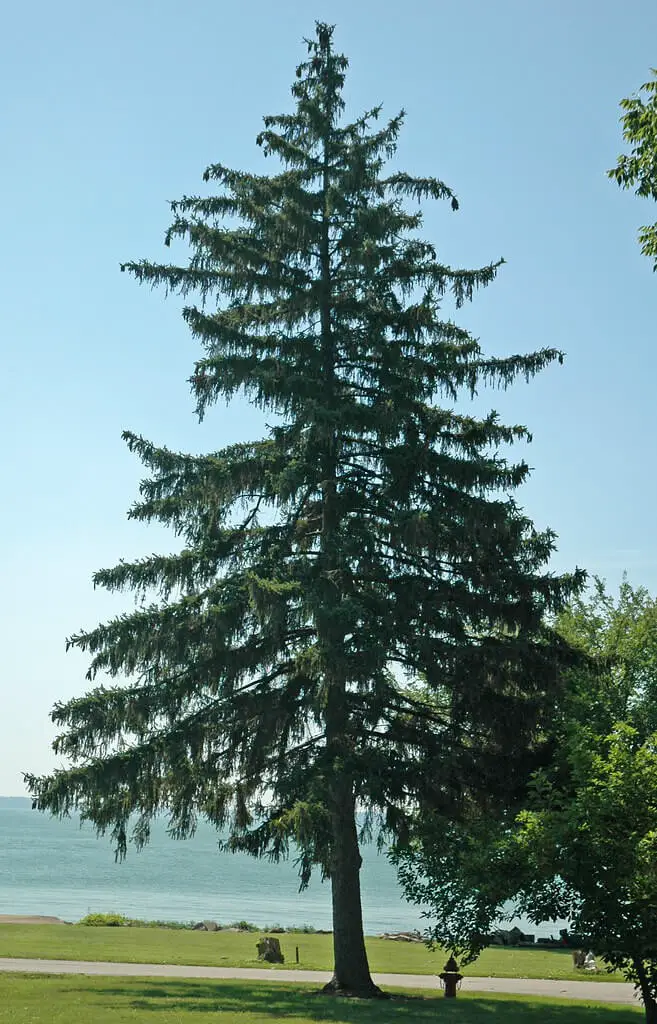
Scandinavian in origin and endemic to Norway, this species of evergreen is renowned for its remarkable growth rate, capable of reaching heights of up to 180ft. Its foliage consists of slender, dark green leaves with pointed tips, exuding a subtle fragrance reminiscent of the classic Christmas pine. While its branches can support light ornamentation, they are unfortunately not sturdy enough to accommodate more substantial decorations.
Furthermore, this tree’s needle retention is poor, making it a high-maintenance option for those seeking a festive centerpiece.
#23. Colorado Blue Spruce (picea pungens)

The Fraser Fir, a native species of Colorado and Utah, can be distinguished by its waxy, bluish-gray needles and curved branches. As winter’s peak approaches, these needles transform into a captivating silver-blue-green hue. Its sturdy branches are well-suited for heavy ornamentation, while the tree itself emits a potent fragrance. With its ideal shape and potential to reach heights of up to 75 feet, the Fraser Fir is often regarded as the quintessential Christmas tree.
How long do Christmas trees last?
While setting up a real Christmas tree can be a delightful experience, it’s crucial to understand the necessary care requirements to ensure it remains healthy and thriving throughout the holiday season. With proper care, a Christmas tree can last for up to five weeks, allowing you to enjoy its festive charm for an extended period. However, if you’re looking to bring one home in November or earlier, it’s essential to familiarize yourself with the basic care requirements.
This includes positioning the tree away from direct heat sources, consistently spraying water on the tips each day, and trimming the needles at the base to prevent drying out.
Which state grows the most Christmas trees?
Indiana County in Pennsylvania held the reputation as the world’s Christmas tree capital from the 1950s to the late 1980s, but this title has since been relinquished to two other states. Since 2012, North Carolina and Oregon have emerged as the top producers of Christmas trees, accounting for a staggering 79% of the total annual US production. While fir species remain the most prevalent, these states have also diversified their offerings to include cypress and cedar strains over the years.
How to grow Christmas trees

To sidestep the chaos of Christmas tree shopping, why not cultivate your own? In fact, it’s crucial to begin the process early, so we’re advising you to get started right away. The process is relatively straightforward: simply follow these steps to grow your own festive fir.
#1. Choosing your tree type
When it comes to selecting the perfect Christmas tree, the first decision is often which species to grow. The options are vast, ranging from classic firs to pines, spruces, cedars, and even cypresses. If you’re looking to evoke a traditional Christmas atmosphere, firs are an excellent choice, offering a timeless and iconic look. For a more exotic or eastern-inspired feel, pine trees can provide a unique and memorable experience.
Alternatively, if you want to mix things up with a less fragrant option and a wider range of color options, spruce and cypress trees offer a distinctive and visually appealing alternative.
#2. Prepare the soil
When it comes to cultivating Christmas trees, it’s essential to first ensure that the surrounding vegetation is cleared or else it can have a devastating impact on their health and potentially lead to widespread mortality. To provide optimal growing conditions, look for well-drained soils that receive full sun exposure. Heavy clay soils should be avoided unless the area has a natural slope, as this can help mitigate any potential drainage issues.
Interestingly, pines tend to thrive in areas with more intense sunlight, while other species may perform better in colder climates.
#3. Maintenance
The early stages of growing a tree can be quite demanding, particularly during the first year when regular watering is crucial. From late spring to mid-fall, it’s essential to provide weekly hydration for the young tree’s roots to establish themselves properly. In contrast, during the second year and beyond, only extreme drought conditions will warrant additional watering. Beyond these initial years, maintaining a healthy tree requires careful attention to weed control and pruning.
It’s also important to note that annual shedding is a natural process for these trees, with approximately 30% of their needles being naturally shed each year.
#4. Harvesting
In terms of botanical ranges, Christmas tree harvest times typically span a duration of approximately nine years, with most varieties reaching maturity heights of around 6 feet. However, smaller-scale growers may experience a slightly accelerated timeline, with their trees ready for harvesting within a period of five to six years.
Where to buy Christmas tree
When it comes to purchasing a Christmas tree, many people opt for the convenience of buying from a nearby retailer. However, if you’re not near a Christmas tree farm where you can cut down your own tree, don’t worry! There are numerous options available at popular retailers across various categories. Some top picks include big-box stores like Lowe’s and Home Depot, as well as grocery chains like Whole Foods.
You’ll also find a range of home improvement stores such as Ace Hardware and the warehouse club Costco. Additionally, department stores like Target offer a variety of Christmas tree options for your consideration.
Conclusion
Christmas trees are an integral part of the holiday season, evoking a sense of nostalgia and festive cheer as soon as the winter months arrive. However, with so many types to choose from, it can be overwhelming to decide which one best fits your home’s atmosphere. It’s crucial to consider factors such as tree type and characteristics to ensure your Christmas tree complements your decor. This knowledge is essential for choosing the perfect tree that resonates with your holiday vibe.
Related Posts
Discovering the incredible diversity of online plant nurseries is a journey that can take you from the familiar apple trees to the majestic evergreens. But did you know that becoming an arborist, or tree care professional, can be a fulfilling career path? In fact, understanding the impact of trees on a property can have significant benefits for homeowners and communities alike.
Whether you’re looking to boost your home’s curb appeal by adding some new greenery or deciding whether to remove existing trees altogether, there are many factors to consider. For instance, did you know that certain plants like the lady palm (Rhapis excelsa) require specific care and attention? Or that growing organic blueberry plants can be a rewarding experience for garden enthusiasts. With so many options available, it’s no wonder why online plant nurseries continue to thrive.


